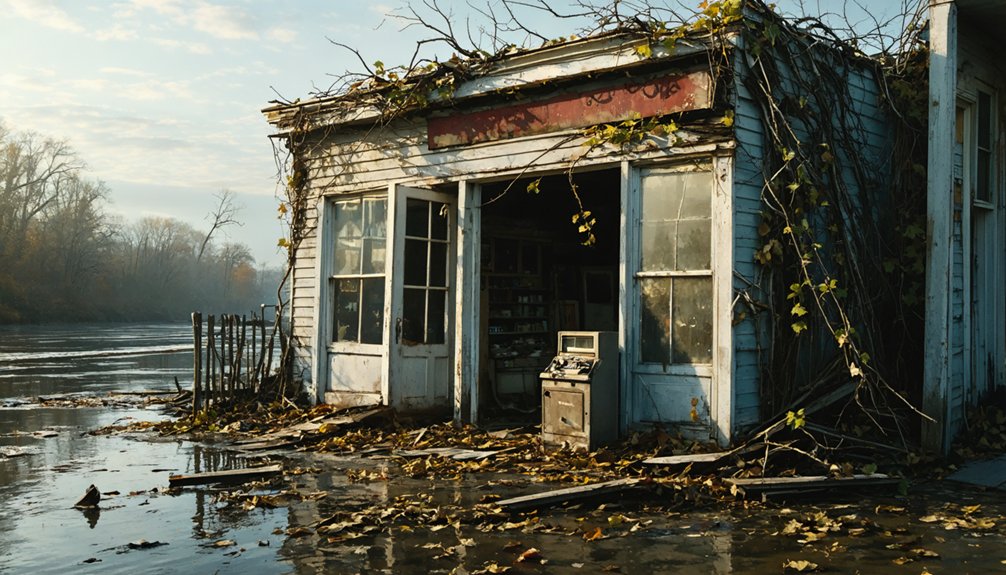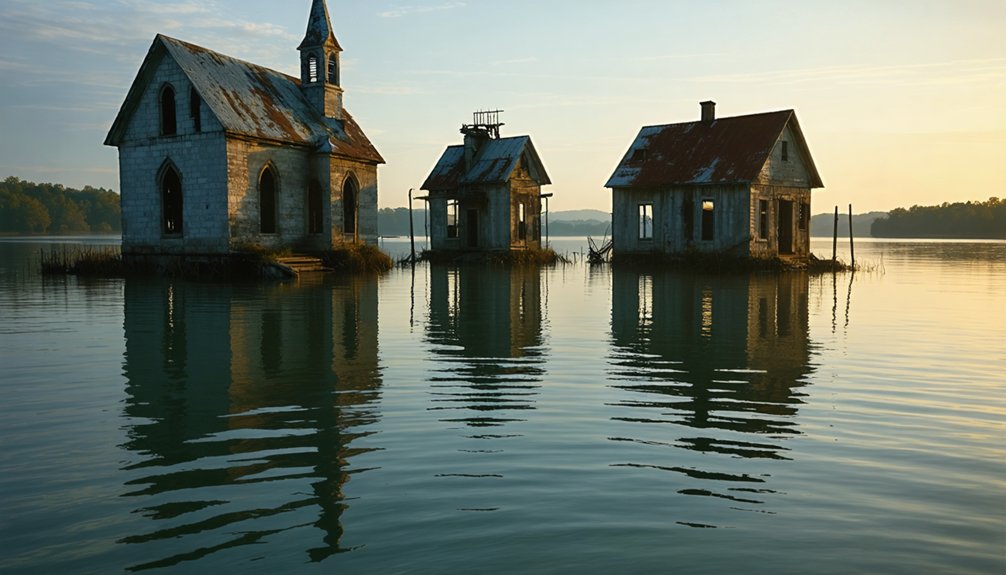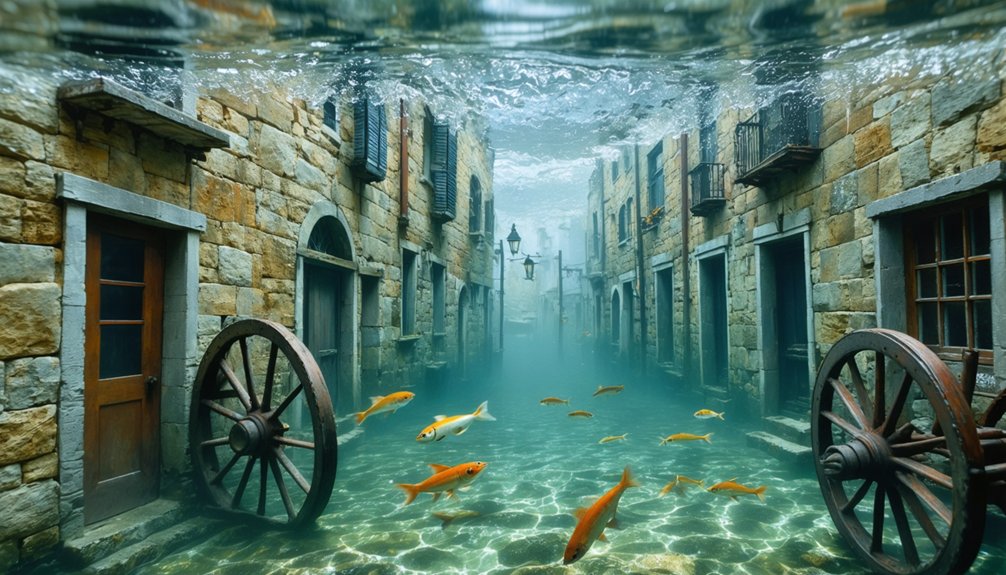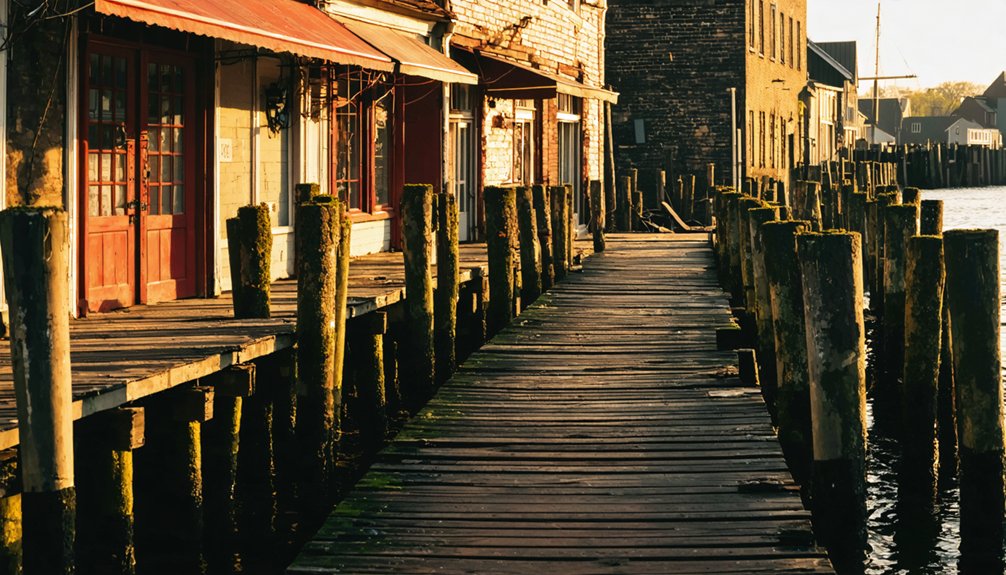You’ll discover America’s river ghost towns through their haunting narratives of hope and devastation. In Cahaba, Alabama’s first capital, seasonal floods eventually drove residents away, leaving archaeological treasures behind. Hopefield, Arkansas vanished after repeated Mississippi River floods, while Bodie, California preserves the gold rush era in “arrested decay.” Some settlements like Flagstaff, Maine now rest beneath reservoir waters, their foundations occasionally revealed when water levels drop.
Key Takeaways
- Hopefield, Arkansas was destroyed by recurring Mississippi River floods and yellow fever epidemics, leaving minimal ruins despite its important rail connections.
- Cahaba, Alabama, the first state capital, was abandoned after devastating floods from two converging rivers triggered economic decline and disease outbreaks.
- Bodie, California stands preserved in “arrested decay,” offering authentic glimpses of Wild West mining life with original furnishings and structures intact.
- Flagstaff, Maine lies submerged under Flagstaff Lake, with water levels occasionally revealing foundations that attract scuba divers exploring submerged artifacts.
- Cairo, Illinois exemplifies river town decline despite its strategic location at the Mississippi-Ohio junction, with abandoned Victorian buildings reflecting former prosperity.
The Rise and Fall of Hopefield: Arkansas’ Mississippi River Casualty
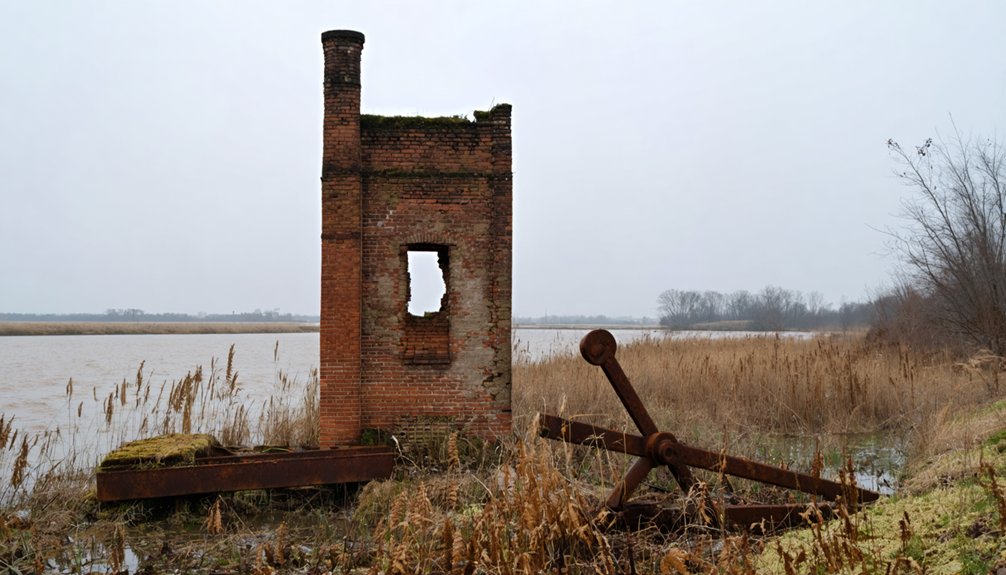
You can trace Hopefield’s history through dramatic cycles of promise and devastation.
After Union forces burned it completely in 1863, resilient settlers rebuilt, establishing essential rail connections to Memphis.
But nature proved a more formidable opponent than war. Repeated Mississippi River floods, coupled with devastating yellow fever epidemics, gradually eroded the town’s foundations—both literally and figuratively. By the 1910s, severe flooding had forced the complete abandonment of Hopefield, leaving only minimal ruins behind. Meanwhile, neighboring West Memphis was developing its own identity as a vibrant entertainment destination with Beale Street West attracting music lovers throughout the 1930s-1950s.
Cahaba’s Ghostly Legacy: When Alabama’s Capital Surrendered to Water
If you’re searching for the ghostly echoes of Cahaba, you’ll find how devastating floodwaters and the 1826 loss of capital status transformed Alabama’s first seat of government into an abandoned curiosity.
Seasonal inundations from the convergence of two major rivers repeatedly swamped the town’s infrastructure, eventually driving away residents despite Cahaba’s brief resurgence as a commercial cotton hub before the Civil War.
Today, archaeological excavations and preserved ruins stand as silent witnesses to the once-promising settlement that surrendered to nature’s watery assault, with most structures dismantled by 1930 despite the town not being officially unincorporated until 1989. The town was originally designed with a grid layout similar to Philadelphia, featuring streets named after trees. Visitors seeking information about this historic site should be aware that disambiguation pages exist to differentiate between the various meanings of Cahaba, including the river, the ghost town, and other namesakes.
Floodwaters End Prosperity
While Cahaba’s strategic location at the confluence of two major rivers initially fueled its prosperity, this geographical blessing would ultimately become its undoing.
You can trace Cahaba’s decline directly to the devastating 1825 flood that submerged the town for weeks, damaging the statehouse and triggering the capital’s relocation to Tuscaloosa.
The flood impact cascaded into economic decline through multiple channels:
- Recurring floods brought deadly outbreaks of yellow fever, malaria, and cholera
- Loss of political prominence led to mass exodus of residents and abandoned buildings
- County seat relocated to Selma in 1866, further diminishing administrative importance
- Civil War disrupted cotton trade and river commerce that had been Cahaba’s lifeblood
Historical records indicate that state legislators were forced to use rowboats for transportation during the aftermath of the catastrophic 1825 flood.
The city’s isolation from major urban centers severely restricted overland transportation options, further contributing to Cahaba’s eventual abandonment.
Historical Ruins Remain
Five crumbling structures remain where Alabama’s first capital once stood, now preserved as Old Cahawba Archaeological Park.
When you walk these grounds, you’re traversing layers of American history – from ancient Mississippian villages with flat-topped mounds to the bustling capital established in 1818.
The site’s historical significance extends beyond its brief tenure as Alabama’s capital. Beneath colonial streets lie remnants of what may be “Maubila,” the Native American settlement destroyed by de Soto in 1540.
Governor Bibb incorporated these ancient earthworks into Cahawba’s design, creating an archaeological palimpsest spanning centuries.
After the devastating 1865 flood, residents dismantled buildings brick by brick, leaving a ghost town where 9,000 Union prisoners once suffered in Castle Morgan during the Civil War. Many of these prisoners later perished in the tragic Sultana explosion while journeying home to their families.
Cahawba archaeology now preserves America’s complex, layered past.
Bodie: Gold Mining Prosperity Frozen in Time

When you walk through Bodie’s deserted streets today, you’ll find everyday items—coffee still in cups, clothes hanging in closets, and store shelves stocked with goods—creating an eerie tableau of life suddenly interrupted.
What began as a humble mining camp after W.S. Bodey’s gold discovery in 1859 exploded into a notoriously lawless boomtown of nearly 10,000 residents by 1880, earning the fearsome reputation captured in a child’s diary entry: “Goodbye God, I’m going to Bodie.” The town’s name originated from a spelling error on a sign, permanently altering what should have been “Bodey.”
Now preserved in “arrested decay” as a National Historic Landmark, Bodie’s 110-plus remaining buildings offer you an authentic glimpse into the raw reality of Western frontier life, complete with abandoned saloons, the red light district, and personal possessions that tell stories of hasty departures. The California Department of Parks and Recreation carefully maintains the town in its state of decay to preserve this important piece of American mining history.
Frozen-in-Time Mining Town
Among America’s most perfectly preserved ghost towns, Bodie stands as a haunting monument to the boom-and-bust cycle of Western mining communities.
When you visit today, you’ll witness a true time capsule of the American gold rush—nearly 200 wooden structures maintained in “arrested decay,” many still containing original furnishings and artifacts from when the last residents departed. This historic site serves as a disambiguation destination for visitors seeking the authentic Bodie ghost town experience.
- At its 1879-1880 peak, Bodie hosted 7,000-10,000 residents and produced $38 million in precious metals.
- The town’s 30 mines, 65 saloons, and numerous brothels reflected its reputation for lawlessness.
- California State Parks maintains Bodie as it appeared in its final years.
- The mining era effectively ended when the Bodie Railway was abandoned in 1917.
Wild West Boomtown Legacy
Behind Bodie’s weathered façades lies a remarkable tale of gold rush prosperity that transformed a small mining camp into one of America’s most notorious boomtowns.
When William Bodey discovered gold in 1859, he couldn’t have imagined the explosion of wealth that would follow. The real boom struck in 1876 when the Bunker Hill Mine revealed substantial deposits, catapulting Bodie to its 1880 peak with nearly 10,000 residents.
You’d have witnessed 31 steam hoisting works and over 400 businesses thriving in this Wild West metropolis.
Though folklore claims $100 million in production, Bodie’s actual mining legacy yielded closer to $34 million—still an extraordinary sum that produced 1.5 million ounces of gold and 15 million ounces of silver before World War II halted operations in 1942.
Preserved Daily Life Scenes
Today, walking through Bodie feels like stepping through a time portal into America’s gold rush era, with over 100 historic structures standing in what preservationists call “arrested decay.”
You’ll find the town’s church, schoolhouse, barbershop, saloons, and general stores exactly as residents left them when the last mines closed in 1942.
Authentic preservation efforts showcase Bodie artifacts that reveal intimate details of frontier life:
- Peek through windows to glimpse bottles, desks, and personal effects scattered throughout abandoned interiors
- Examine the Boone & Wright store with original documents still stuffed in cabinets and trunks
- Notice unique architectural adaptations like metal siding made from flattened kerosene cans
- Discover unlooted treasures—ledgers, letters, and everyday items—ignored by vandals for decades
The California Department of Parks maintains this frozen tableau without restoration, preserving the raw authenticity of America’s mining past.
Harrisburg’s Struggle Against Nature: A Utah Settlement’s Retreat
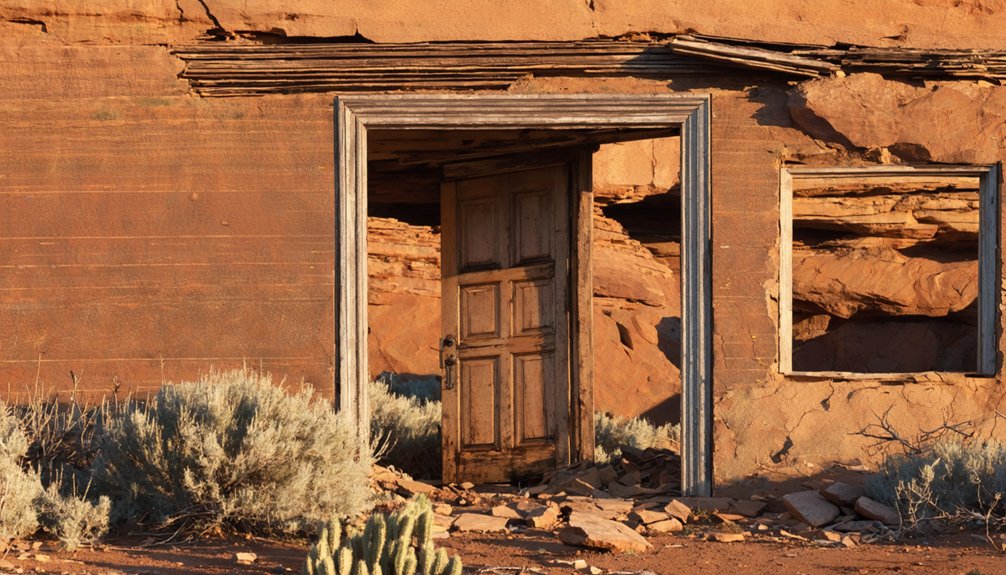
When Moses Harris and several Mormon families established Harrisburg in 1859, they couldn’t have foreseen the relentless battle against nature that would ultimately force them to retreat.
Nestled near the Virgin River in Utah’s red cliff country, their community resilience was immediately tested when catastrophic flooding in 1862 submerged their settlement, forcing relocation to higher ground.
You’ll find that environmental adversity continued to plague these pioneers—recurring floods, devastating grasshopper infestations, and the region’s arid soil created near-impossible farming conditions.
Despite their determination, these challenges, combined with Native American conflicts over ancestral lands, eventually overwhelmed the settlement.
Beneath the Surface: Flagstaff’s Submerged History
Unlike many ghost towns abandoned to the elements, Flagstaff, Maine lies preserved in a watery tomb beneath the surface of Flagstaff Lake.
When Central Maine Power Company built the Long Falls Dam in 1950, they sacrificed entire communities for hydroelectric progress. You can still glimpse ghostly echoes of this once-thriving valley when water levels drop, revealing foundations and street patterns from a community that refused to leave until the waters literally rose around them.
- Scuba divers regularly explore submerged artifacts, including building remnants frozen in time
- The 1949 “Old Home Days” marked the final gathering before inundation
- During droughts, the lake reveals more of its underwater secrets
- Relocated structures like the schoolhouse stand as memorials along the shoreline
Cairo’s Decline: When River Commerce Abandoned a Once-Thriving Port
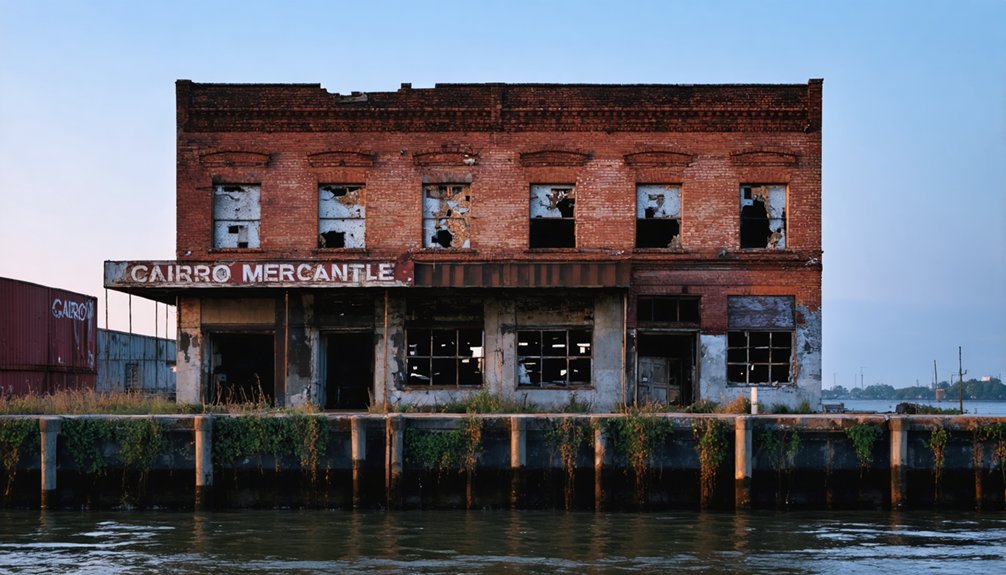
At the junction of America’s two mightiest rivers, Cairo, Illinois once embodied the promise and prosperity of America’s waterway commerce.
You can still glimpse its former grandeur in abandoned Victorian buildings that once housed merchants who profited from bustling river trade.
When the Illinois Central Railroad bridged the Ohio in 1889, Cairo’s strategic advantage began to erode.
The city’s decline accelerated through racial tensions that erupted in the 1960s, driving businesses away as white residents fled to neighboring towns.
The Role of Water in Shaping America’s Ghost Towns
Cairo’s story mirrors a broader pattern across America where water—once the lifeblood of commerce—ultimately shaped the destiny of countless settlements.
You’ll find these aquatic ghosts scattered across the national landscape, their fortunes tied to rivers that first gave them life, then sealed their fate.
- Towns flourished along riverbanks as river commerce created economic prosperity through mining, logging, and agricultural trade.
- When railroads bypassed waterways, these once-bustling ports suffered rapid economic decline.
- Devastating floods and dam construction submerged entire communities, leaving only memories and folklore.
- Environmental degradation from industrial activities poisoned the same waters that once sustained these towns.
These watery ghost towns serve as powerful reminders of how technological change, natural forces, and human decisions can transform thriving communities into forgotten footnotes in America’s historical narrative.
Preserving Memories: Historical Conservation Efforts of Flooded Settlements
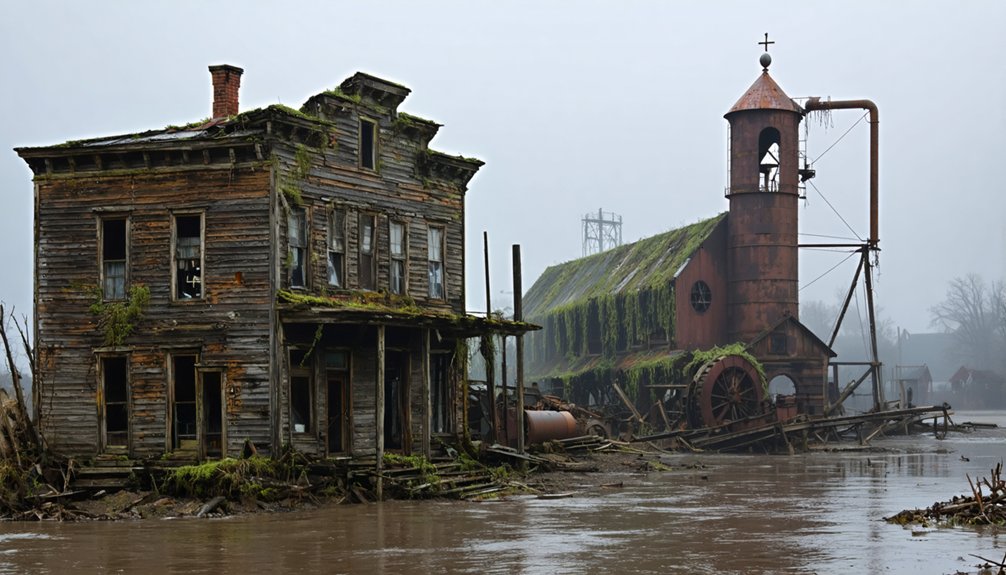
Beneath the still waters of America’s reservoirs lie the silent remnants of once-vibrant communities, their stories preserved not just in memory but through dedicated conservation efforts.
When you visit these flooded settlements, you’re witnessing the culmination of multi-organizational partnerships between local historical societies, government agencies, and non-profits like the Ghost Town Club of Colorado.
These collaborations employ cutting-edge 3D mapping technology to document submerged structures before they’re lost forever.
Conservation efforts require substantial funding—from thousands for smaller projects to tens of thousands for extensive restorations. Your donations and community support sustain these initiatives, enabling preservation teams to stabilize remaining structures using period-appropriate materials and techniques.
Remember to respect the ethical guidelines when exploring these sites: remove only trash, avoid disturbing artifacts, and honor private property boundaries.
These standards guarantee these underwater histories remain accessible for future generations.
Touring America’s River Ghost Towns: What Remains Today
Flowing alongside America’s waterways, the spectral remains of once-thriving river towns offer glimpses into a bygone era of American expansion and industry.
Today, you’ll find these haunting settlements in various states of preservation, from carefully maintained historical parks to crumbling ruins slowly reclaimed by river ecosystems.
- Bodie, California showcases 110 structures in “arrested decay,” offering the most authentic ghost town tourism experience.
- Historic mining operations remain visible at riverside settlements like Harrisburg, where restoration efforts preserve the last standing structures.
- Many towns are accessible only via scenic drives or hiking trails, rewarding adventurous explorers with untouched historical landscapes.
- Interpretive signage and museums at sites like Silver City bring to life the stories of those who once called these waterside communities home.
Frequently Asked Questions
Are River Ghost Towns Safe to Visit During Flood Seasons?
No, you shouldn’t visit river ghost towns during flood seasons. Take flood precautions seriously and follow safety guidelines—these abandoned settlements lack infrastructure and warning systems for rising waters.
What Paranormal Investigations Have Been Conducted in These Locations?
You’ll find extensive paranormal investigations at these towns, with teams documenting ghostly sightings through EVP recordings, thermal imaging, and EMF readings—capturing whispers, apparitions, and unexplained temperature drops using scientific investigative techniques.
How Do Locals Feel About Tourism to These Abandoned Towns?
Like sentinels guarding forgotten treasures, locals harbor mixed feelings. You’ll encounter those who welcome tourism’s economic benefits, while others lament the disruption to their once-peaceful havens along America’s forgotten riverbanks.
Were Any Artifacts Recovered From Flagstaff Before the Flooding?
Yes, you’ll find numerous Flagstaff artifacts were recovered before flooding events, including prehistoric pottery, tools from Turkey Hill ruins, and Native items dating to 1050 AD that reveal the area’s rich history.
Can Visitors Access Cairo’s Abandoned Buildings Without Special Permission?
Trapped in time like ghosts of the past, you can’t legally access Cairo’s abandoned buildings without permission. Urban exploration here risks trespassing charges and undermines historical preservation efforts aimed at protecting what remains.
References
- https://www.youtube.com/watch?v=s2a3hAf5d-Y
- https://www.wideopencountry.com/the-10-eeriest-ghost-towns-in-america/
- https://www.geotab.com/ghost-towns/
- https://www.youtube.com/watch?v=ffzJ2lHljl8
- https://www.mentalfloss.com/geography/wanderlust/creepiest-ghost-towns-united-states
- https://www.youtube.com/watch?v=pinIgUFWDT0
- https://www.lovemoney.com/gallerylist/86648/americas-empty-ghost-towns-and-why-theyre-abandoned-today
- https://www.atlasobscura.com/lists/americas-best-preserved-ghost-towns
- https://en.wikipedia.org/wiki/List_of_flooded_towns_in_the_United_States
- http://www.westmemphisutilities.com/278/How-We-Began
